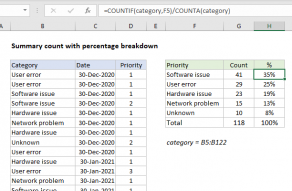Explanation
In this example, the goal is to return a count for each color that appears in column C, using the color values already in column E as criteria. When working with data, a common need is to perform summary calculations that show total counts in different ways. For example, total counts by category, color, size, status, etc. The COUNTIF function is a good way to generate these kinds of totals. Also included below are links to a pivot table option and a dynamic array formula option. Both of these alternatives can automatically extract the values to count and generate the counts at the same time.
COUNTIF function
The COUNTIF function takes two arguments: a range of cells to count, and the criteria to use for counting. For example, to count cells equal to "red" in a range, we could use COUNTIF like this:
=COUNTIF(range,"red") // count "red" cells
In this example, we want a count for 3 colors, so we have manually created a small table that lists all colors in column E. This allows us to use the color names in column E both for labels, and for the criteria that goes into COUNTIF as the second argument. The formula in cell F5 is:
=COUNTIF(color,E5) // returns 3
where color is a named range for cells C5:C16. As the formula is copied down, it returns a count for each of the three colors shown in column E. Notice because we are testing for equality, we don't need to use any logical operators in criteria. We can simply use the value in cell E5 directly for criteria.
By default, named ranges behave like absolute references and do not change when copied. This means the reference to color does not change, while the reference to E5 is relative and changes at each new row. Alternately, we could use an absolute reference instead of a named range like this:
=COUNTIF($C$5:$C$16,E5) // absolute address
The formula above will return the same results.
Pivot table solution
If you have a limited number of values to count this is a good solution. However, if you have a large list of values that will change over time, a pivot table is a better option since it will automatically expand to include new data.
Dynamic array formula solution
Now that dynamic array formulas are part of Excel, it is possible to build a dynamic summary count with formulas, including an all-in-one formula. Like a pivot table, a dynamic formula will automatically expand to include new data. Unlike a pivot table, formulas recalculate automatically and do not need to be refreshed.















